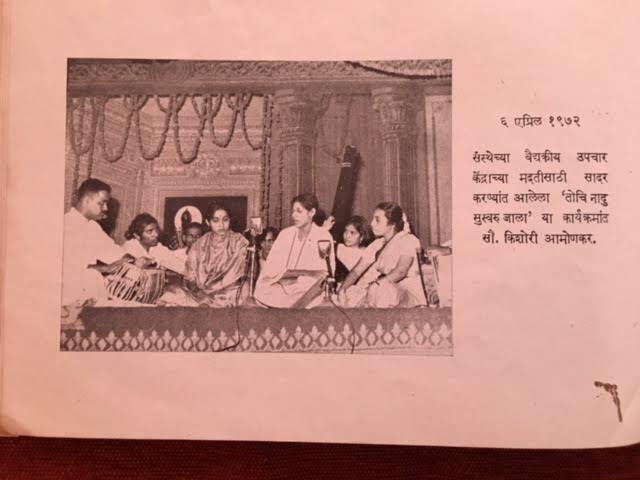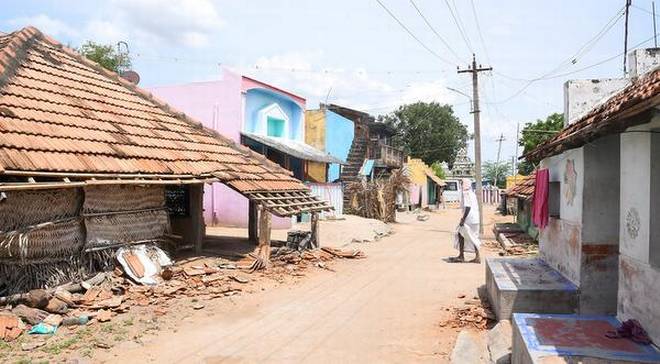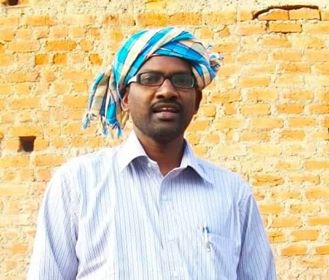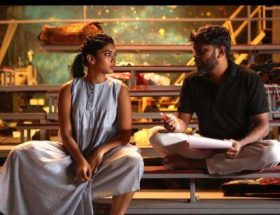Anjali Arondekar
This interview emerged as a series of email exchanges between Rohan Arthur and Dr. Anjali Arondekar who works on the Gomantak Maratha Samaj archives, following Rohan’s tribute essay on Kishori Amonkar titled Kishori Amonkar: Assertion, Erasure, Reclamation. The interview was conducted with inputs from James Michael and Akshay Pathak.

Can you describe the historical origins of the Gomantak Maratha Samaj, its bifurcation into the Naik Maratha Samaj and Nutan Maratha Samaj? Most importantly, can you talk about the Samaj’s complex relationship with OBC classification? Some news reports suggest that the Samaj did not want to be classified as OBC. Does this have something to do with the caste constituency of the Samaj? Was/Is the Samaj being ideologically driven by the relatively more affluent castes within its fold? What do the other lesser-privileged castes within the fold think of this conflictual relationship with the classification?
First, let me begin with some broad historical information, and then I’ll get to the more weighty and thorny question of how caste mutates as an attachment within different regional formations of the collectivity. My sense (from now having worked in the Gomantak Maratha Samaj archives for over a decade) is that its history is an open secret (to borrow a phrase from sexuality studies!). Often referred to as Bharatatil ek Aggressor Samaj (an aggressive community in India), this collectivity is routinely lauded (by the left and the right in India) for its self-reform and progress. From the immortal Mangeshkar sisters (Lata and Asha), to the first chief minister of independent Goa, Dayanand Bandodkar, there are few sectors of Indian society where the presence of Samaj members cannot be felt. In other words, we celebrate the Gomantak Maratha Samaj’s (henceforth the GMS) success as a collectivity, even as we disavow or simply erase the very histories of sexuality that produce its success in the first place. The recent passing of Kishori Amonkar is a case in point. While she has been memorialized as the stalwart musician and pioneer that she was, most of the articles I have read about her routinely elide her relationship to the GMS. Even when that relationship is cited (as it has been in the pages of this site as well), it is cast in the usual language of tragedy –- calling on readers to remember her as an OBC, via an iconography of loss and paucity. I have always found such tragic recuperations of the GMS troubling as the history I know, have studied, and indeed lived (as a member of GMS myself) speaks to more complex genealogies of caste and sexuality. Kishoritai, for example, was a very visible and supportive member of the Samaj, and I myself remember attending many Samaj functions in which she participated and or sang. In fact, the most recent monthly publication of the GMS (the Gomant Sharada) celebrates her many contributions and significance to the GMS in lively and joyful terms. The challenge here is how do we tell a history of caste, gender and sexuality that is not always a history of loss and erasure?
Let me turn now to the specific historical trajectory of the GMS. The Samaj draws its members from complex groupings of Goan Devadasis, and traces its roots back to the early 1800s. Appearing first as a formal community in 1927 (its constitution was drafted in 1929), the GMS continues to this day to provide services, scholarship and outreach to over 10,000 members all over Goa, western Maharashtra and Karnataka. It officially became a charitable institution in 1936. Unlike well-documented histories of Devadasi reform, particularly in Southern India, this community’s story in Portuguese Goa underwent very little transformation and exposure, until the early part of the twentieth century. Kalavants in the GMS community, unlike the Devadasi figurations in Southern India, rarely wed deities and were not “prostitutes” in any conventional sense of the word. Rather, Kalavants were mostly female singers, classically trained, placed through ceremonies like “hath-lavne” into companionate structures with both men and women. Only occasionally do we find references to dedications to deities through rituals such as the “shens” ceremony. And even then, the ceremony appears more as a proxy wedding in which a girl who is to be dedicated to a god or goddess, is wed to a (surrogate) groom always represented by another girl dressed as a man, holding a coconut and a knife in hand.
As the story goes, the Goan Saraswats were historically the primary patrons of the Devadasis and devised a structure that demarcated “kalavants” who were either “ghanis (singers)” or “nachnis (dancers) or both, “bhavnis” (women who attended to temple rituals) and “fulkaris” (flower collectors). Of significance here is that both men and women did menial and physical labor on the farmlands of the Saraswat Brahmins and the Mahajans (elders associated with religious institutions) and were named “chede” or “bande,” literally bodies tied to the land. Included within the Goan Devadasi structure were also “Chadde farjand” or “frejent,” a Persian term literally meaning “boy” but that principally applied to sons of single mothers who had sex with their employers. These latter groups of boys were referred to as “deuli” (male members of the Bhavin class) and were situated lower than the “kalavants” within the Devadasi sub-structures.

Central to the Samaj’s self-definition was and is its eschewing of any antagonistic relationship to its past. That is, its members were/are rarely encouraged to gently nudge their linkages to Devadasis into the closet of history; rather such connections are drawn out, often ad nauseum, to attest to the community’s success and presence in contemporary society. Thus, for example, since its inception in 1927, the Bombay branch of the Samaj has held yearly public functions that celebrate the past and future successes of its members. Such functions routinely draw upon references to Devadasi genealogies to attest to the artistic and religious wealth of the community. Initial efforts to organize the community were primarily led by Rajaram Rangoji Paigankar in 1902. Paigankar particularly rallied youth members of the community and staged multiple successful conferences all over Goa, and Maharashtra. The belief was that education and caste-reform could bring power to the community, not at the expense of erasing past histories, but rather by building on the legacies of the past. Based primarily in Panaji, Shiroda, Malvan and Bombay, the Samaj championed itself as caste-reformist (if you will), describing its shift in name from Gomantak Kalavant Samaj, to Gomantak Maratha Samaj, as a primary indication of its commitment to a progressive pan-caste politics. As Paigankar argues in his biography, Mee Kon? (Who am I?), the leaders of GMS deliberately expanded their movement in the 1930s through their inclusion of the word “Maratha” in their self-nominalization. Saraswat scholars of the period often dismiss such an inclusion, arguing that regardless of such attachments, the Kalavants were not Marathas.
Such shifts in identity were radical as they made caste status inherently mobile and accessible, an option previously unavailable to members of GMS. Thus, it is crucial to recall that in the early declarations of the Samaj Sudharak (the monthly publication of the GMS), Paigankar and his collaborators strongly emphasize the inclusion of the Deuli community alongside its Kalavant members, gesturing to a uniform caste identity for all sub-groups under the rubric of the Gomantak Maratha Samaj. A key feature of these early endeavors was GMS’s concerted commitment to linking its own histories of sexuality and self-fashioning to a larger societal narrative of reform. The very first editorial of GMS’s monthly publication, Samaj Sudharak, goes to great length to explain why the publication is so loftily called Samaj Sudharak and not simply the Gomantak Maratha Samaj Sudharak. Entitled “Our Courage,” the editorial justifies the choice of name by foregrounding the absence of public debate on questions of sexuality, caste and tradition, particularly within Marathi language publications. For the editors, societal reform is impossible without an exposure of such issues, and their goal is to use the experiences of GMS members to slowly but surely enlighten larger society on these questions (Vol. 1, January, 1929).
A second key feature of the GMS is that is has maintained a commitment to creating its own archives and crafting its own histories. The Samaj, from its inception, has maintained a continuous, copious and accessible archive of its own emergence, embracing rather than disavowing its past and present attachments to sexuality. The Samaj’s archives (housed in Panaji and Mumbai) constitute an efflorescence of information in Marathi, Konkani, and Portuguese, ranging from minutes of meetings, journals, newsletters, private correspondence, flyers, programs, all filled with details of the daily exigencies and crises that concerned the community. I mention the vastness and abundance of the archives because these materials are open and accessible to all and yet have rarely been used or cited in histories of caste and sexuality in India.

In terms of your specific inquiry about the different caste formations of the GMS within different regions, there is no clear-cut answer. On the one hand, as kalavantins, the Samaj members were seen as distinct from the category of ‘prostitute’ created by the Portuguese colonial state primarily because these women maintained coercive and non-coercive monogamous relationships with Saraswat Brahmin men (and occasionally women). As the children of such unions were rarely recognized as legitimate heirs to their fathers’ caste status and/or properties, a variety of creative forms of kinship were developed to survive and prosper. In some cases, the children took on their fathers’ Saraswat Brahmin surnames (without consent) such that there are now Samaj members in both Goa and Maharashtra that have deceptively upper-caste surnames such as Kakodkar, Shirodkar and Welingkar. While these members are clearly not received as brahmins in larger society, their acquisition of Brahmin surnames has created sufficient confusion within normative kinship structures. Given the primacy of blood and laws of primogeniture, such ‘sleights of caste’ are more than efforts at upward mobility. On the other hand, if you follow the history of Dayanand Bandodkar, the first chief minister of liberated Goa, you find a story of lower-caste capitalism that instrumentalises caste towards electoral ends. Yet, Bandodkar’s remarkable unification of Bahujan communities in Goa against Brahmin hegemony continues to remain a feat of extraordinary historical value. I would say that for decades after the liberation (or at least until the 1990s), the Bahujan/OBC nexus remained a source of identification for most GMS members. It is only in the past two decades that some affluent GMS members in Goa have begun to articulate a discomfort with their lower-caste histories. I would reiterate here that such caste tensions are not shared by the majority of GMS members in Goa who still live in more rural centres and benefit greatly from the Samaj’s charitable efforts and ambitions to “uplift” their community.
In Maharashtra, or more specifically in Mumbai, there is no such disavowal of OBC histories or struggles. The most interesting case, however, is the history of the GMS in Karnataka. I recently attended several meetings of the GMS in Hubli, Karnataka, where there is strong membership and a fervent collective desire to expand the outreach of the GMS’s charitable efforts. At one of the meetings, I noticed that the banner at the head of the room read “Gomantak Saraswat Samaj.” Struck by this odd nominalization (after all, the GMS is an OBC and not Saraswat (read Brahmin) Samaj!), I asked the secretary the story behind the name; I pointed out that the name could be misleading in terms of its caste identifications. Chuckling at my query, the secretary quietly pointed out that the GMS members were all devotees of the Goddess Saraswati, and of learning in general, and there was thus no restriction on who could be called a Saraswat! Learning, he reminded me, rather sternly, is not just the provenance of the Brahmins.
The exploitative slavery of sexual labour was perpetuated not just by male Saraswat Brahmins but also by women as you mention. How does that help us understand the structures of power in a caste economy? What were the roles of savarna women in sustaining this exploitative order?
This is much too broad a question to answer in the space of such a short interview. Suffice to say that Brahmin women did often serve as yajemans (patrons) to the GMS women. In most cases, these were relationships of patronage through which GMS women learnt the arts, or a form of trade, that would either service the yajeman’s family, or alternately led to their independence from the yajeman. Yes, there was clear exploitation within these gendered formations but the sexual labors GMS women performed extended primarily to male Saraswats and not to women. One curious effect of such systems of kinship and patronage is savarna women increasingly becoming more involved in the arts, not just as patrons, but also as practitioners. In fact, many archival accounts from the 1920s and 1930s, for example, reveal the increased anxiety amongst Savarna women that the arts (that halcyon space of upper-caste privilege) was gradually being usurped by the increased skills of the Kalavant women.
Colonialism seems to have brought in paradigmatic changes to the status of the caste communities that make up GMS, especially in terms of their caste mobility. However, savarna narratives, including historiography, have tended to demonise colonialism even as they seem to have benefitted the most from the colonial machinery. This is especially true if we were to consider popular Goud Saraswat Brahmins narratives regarding Portuguese rule. In this context, what is the relationship of GMS to the colonial past both historically and in terms of their narrativisations?
This is an excellent question, especially as it pushes against the demand of a dominant nationalist historiography that casts colonialism into the familiar role of one-dimensional villain, or “demon” as you ironically note (Ravana, as many feminists have noted, is a much-misunderstood mythological character!). Speaking specifically to the histories of the GMS, I would say that the Samaj directly benefitted from the patronage of the Portuguese state that provided them with funds to build schools, libraries and more. In fact, there are many archival images of Portuguese colonial officials cutting ribbons at Samaj functions, as late as the 1940s. That said, this was clearly not a simple relationship in which the Portuguese were seen as saviors or helpers in the GMS’s fight against Saraswat hegemony. Rather, my sense from the materials I have looked at is that the Samaj members understand the strategic role the colonial state could play in securing them rights and representation, especially when it came to challenging the monopoly the Saraswats had over farmlands and trade. I have written about this in one of my published essays where I cite the example of a fake “hulla”/attack that is staged by a prominent Samaj member specifically to elicit the judicial support of the Portuguese state. In other words, the “kala” of the Samaj is that it understands the tamasha of colonialism, and uses it in all its multiple avatars to further its own political projects. Thus, it is no coincidence that once Bandodkar starts mobilizing Bahujan collectivities, the Samaj immediately severs its relationships with Portuguese officials. In one archival account, a Samaj elder tells the story of how Bandodkar requests the Samaj trustees to no longer extend invitations to Portuguese officials as it would hinder his credibility and reputation. Similarly, many Samaj men and women fought in the liberation movement, and their histories have yet to be written.
You mention above that in the early twentieth century savarna women were getting increasingly anxious about arts in general being gradually usurped by Kalavant women who came to possess increased skills. Could you please tell us more about this? Anti-caste understanding is that art forms were most often appropriations of bahujan labour and culture.
What I mean here is that Saraswat women refused to acknowledge sexuality and sex as a transactional form within their husbands’ dealings with Samaj women. Instead, the cover story of the arts became the reason “why those Samaj women were so successful in stealing their husbands and men,” especially in urban centres such as Bombay. There are several editorials, for example, in Marathi newspapers of the time that call on savarna women to develop an interest in the arts so that they can keep their husbands from running astray. Amusing and delusional as this may sound to us now, it is important to consider how such articulations of interest rerouted “kala” back to upper-caste communities that were to seen to have somehow lost or displaced art/s along the way and, at the same time, completely camouflaged the sexual labour of lower-castes involved in the process. My fear is that we routinely do that as well, even as we strive to foreground bahujan labour and cultural formations. In other words, yes, claim the arts back for the bahujan collectivities, but do not elide or erase the histories of sexuality that constituted that kala in the first place!
Can you shed some light on the lived experiences of contemporary artists from your community especially with regard to their caste identities? Are they, for example, still forced to hide their identities? We tend to think many of these popular star artists as brahmins.
I cannot speak authoritatively about the “lived experiences” of contemporary artists from the GMS as I have not done any ethnography or research on this issue. What I can say from my “lived experiences” within the Samaj is that there is little secrecy around the caste identities of the community’s kalavants. As I noted earlier, our Samaj was financially supported through the labors of artists such as Mogubai Kurdikar, Kesarbai Kerkar, Lata Mangeshkar and Kishori Amonkar. The Samaj archives contain many references to large public concerts held by Samaj artists to raise monies for the Samaj’s charitable efforts. These concerts date back to the early 1930s and continue to this day. In fact, right before Kishoritai passed away, she was the chief guest at a large public event (December 23, 2016) where the chowk that houses the GMS building in Mumbai was named the Gomantak Maratha Samaj Chowk under the aegis of the Mumbai Municipal Corporation. It also marked the 89th year of the Samaj’s establishment and was a moment of great historical poignancy and recognition. That said, it is also important to point out that the kalavants from our Samaj performed (and continue to perform) smaller less-celebrated artistic labors as musicians, back-up singers, poets, stage designers and so much more. I am always reluctant to surrender to the anointment of only well-known figures (such as Amonkar) while countless other kalavants continue to toil outside the limelight. For your readers, for example, who are interested in the public contributions of the Samaj kalavants in spaces such as Girgaum, I would urge you to look at a recent project undertaken by Tejaswini Niranjana and Surabhi Sharma on public spheres of music in Mumbai.
So, to go back to your question, the irony here is not that Samaj members hide or cast(e) away their Samaj connections, but rather that broader historiographies of music and art routinely elide such connections as unimportant or incendiary. As I have stated before, our Samaj’s histories are accessible and well-known, yet little has been written on them, despite their availability and public profiles such as as “Bharatatil Ek Aggresor Samaj.”
You speak of the strategic role that Portuguese colonisation played in securing the rights and representations of GMS. The church could be understood as one of the main mediators of the Portuguese colonial apparatus. With brahmins (bamonns) converting in large number to Christianity, how did this relationship pan out, especially in the context of an emergent Hindu identity being forged across the subcontinent and GMS being implicated in this?
A short answer to your question can be found in the geographical distribution of the Portuguese empire in Goa. Most of the devadasi strongholds in Goa were in areas of what we now call as “New Goa,” where the scale of conversion was less marked and exploitative. The yajemans of the Goan devadasis were mostly drawn from the “non-converted” Saraswat communities, and I have as yet found little evidence that would suggest otherwise. That said, the influence of the Catholic Church was felt more at the level of education reform where Samaj members were encouraged to read and learn Portuguese over any mastery of Konkani, Marathi or Sanskrit.
Lastly, the “Hindu” identity of the GMS must also be seen as a strategic formation. It is curious, for example, that the Samaj did not align itself with any other lower-caste communities in Maharashtra, even as Bandodkar was rallying Bahujan unity in Goa. In other words, even as the Samaj was actively claiming OBC status for its members in Maharashtra, it did not collaborate or campaign with any of the burgeoning lower-caste movements in Western Maharashtra (such as the Satyashodhak Samaj) from the 1920s onwards. Rather, self-preservation and self-promotion were key features of their public platform. Such a distancing from lower-caste movements is especially noteworthy as we witnessed a completely antithetical political strategy in Goa, and to a smaller extent, in Karnataka. I would wager here that it is this precise diversity of caste “consciousness” that complicates any effort to historicise (indeed memorialize) the Samaj as an exemplar of lower-caste success. What interests me most is the protean nature of the Samaj’s uneven and often counter-intuitive caste politics, a politics that pushes us to unmoor ourselves from the settled histories of opposition we seek and indeed desire.
~~~
Dr. Anjali Arondekar is an Associate Professor at the Department of Feminist Studies at the University of California. A list of Dr. Anjali Arondekar works on the Gomantak Maratha Samaj:
1. “What More Remains: Slavery, Sexuality, South Asia History of the Present, Fall 2016, Vol. 6:2, 146-154
2. “Timepass: A (Queer) View from South Asia,” Special Issue, “Queer and Now,” The Writing Instructor, Spring 2015
3. “In the Absence of Reliable Ghosts: Sexuality, Historiography, South Asia, “Differences: A Journal of Feminist Cultural Studies, 25:3, 2015, 98-121
4. “Subject to Sex: A Small History of the Gomantak Maratha Samaj” in Ania Loomba and Ritty Lukose, Ed. South Asian Feminisms: Contemporary Interventions (Durham: Duke University Press, 2012), 244-65










